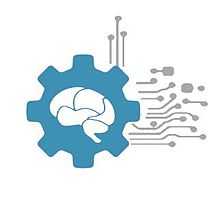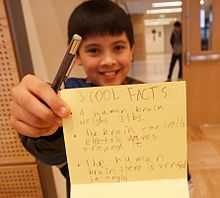Center for Sensorimotor Neural Engineering
 CSNE Logo | |
| Formation | August 15, 2011[1] |
|---|---|
| Location |
|
Director | Rajesh Rao |
Deputy Directors | Kee Moon, Chet Moritz, Joel Voldman |
Previous Directors | Yoky Matsuoka, Thomas Daniel |
| Website | http://www.csne-erc.org/ |
The Center for Sensorimotor Neural Engineering (CSNE) is an Engineering Research Center funded by the National Science Foundation to create devices to restore or augment the body's capabilities for sensation and movement. The National Science Foundation awarded the CSNE with a $3 million grant in 2011, effectively launching the Center.[1]
The CSNE is based at the University of Washington, and its main partner organizations are Massachusetts Institute of Technology (MIT) and San Diego State University.
CSNE researchers specialize in fields related to neural engineering including: Biological and traditional engineering, computer science, applied mathematics, neurological surgery, neuroscience and neurobiology and philosophy. Center faculty also hail from various fields of medicine and assist with real-world implementation of designs.[2] The CSNE places a strong emphasis on neuroethics, exploring how ethical issues such as identity, privacy, and moral or legal responsibility in relation to the expanding field of neural technologies.
Mission
The CSNE’s mission is to develop innovative ways to connect a deep mathematical understanding of how biological systems acquire and process information with the design of effective devices that interact seamlessly with people.[3]
Research
Testbeds
- Brain-controlled spinal interface
- Brain-computer interface for robotic control
- Neural interfaces for assistance and augmentation
Thrusts
A Research Thrust is the fundamental knowledge or basic research that investigators bring to the Center. These thrusts feed into technologies that exist and that CSNE researchers are focusing on, including electrocorticography, the practice of placing electrodes on the brain to record electrical activity. These new technologies are then integrated into research testbeds.[4]
Thrust 1: Communication and Interface
The Communication and Interface thrust is largely concerned with developing more intelligent ways of extracting information from the brain, interpreting them , and then providing feedback to the neural system.[5] The objective of developing these intelligent systems is to use less power to compute faster, and, potentially, harvest their power through innovative sources. At the same time, these systems must be user-friendly. In other words, they must be easy to use and reliable in mechanical design and computation functions. The objective of this thrust is to develop an electrocorticography (ECoG) system that is compact and power efficient enough to be fully implantable.
Thrust 2: Computational Neuroscience
The object of Thrust 2 is to develop a fundamental understanding of the computations and representations carried out in neural systems. A deeper understanding of the brain's computation will inform design of sensorimotor devices for neural control and allow for more targeted future work on investigating neural function.[6] Using this knowledge, inorganic systems can be better engineered to better interact with the brain's endogenous system of computation.
Thrust 3: Control and Adaptation
The Control and Adaptation thrust specializes in creating interfaces that adapt deliver feedback and adapt to a system's user.[7] The benefits of these systems is that they do not require constant intervention to change their behavior. Therefore, instead of reprogramming devices to understand new phenomena, devices would be designed to adapt on their own according to the needs of an individual user.
Thrust 4: Neuroethics
The Neuroethics thrust is concerned with understanding and exploring ethical issues like privacy, normality, and moral or legal responsibilities in relation to neural technologies.[8] One focus is on ensuring that people with disabilities are involved at every point in the development of the technologies that are ultimately aimed at assisting them. The neuroethics team conducts focus group discussions with these "end users" to help guide the work of other CSNE researchers concerned with developing these assistive systems.
Educational Programs

The CSNE places emphasis on more than completing research; it also emphasizes educating the next generation of researchers. While this includes traditional programs at the graduate level, the CSNE participates in programs designed to educate undergraduates, K-12 students, and K-12 teachers. The CSNE uses these programs to encourage diversity and inclusion of minorities and persons with disabilities.[9] The CSNE operates as a host site for NSF programs, including: Research Experiences for Undergraduates and Research Experiences for Teachers.
Research Experiences for Undergraduates (REU)
As a host site for NSF's REU program, the CSNE hosts students from across the United States for ten weeks during the summer. REU students conduct research in CSNE labs, attend lectures and take part in classes covering scientific communications and research methods.
Research Experiences for Veterans - University Projects (REV-UP)
The Center sponsors a program for veterans on the University of Washington's Seattle campus. Similar to the REU program, participants from across the United States take part in research at the interface of biology and engineering for ten weeks during the summer. REV-UP participants work in CSNE labs, attend lectures and learn about scientific communications and research methods.
Research Experiences for Teachers (RET)
Similar to the NSF REU program, the RET program places teachers in CSNE labs. Participating teachers develop lesson plans to take back to the classroom; these lesson plans are posted on the CSNE website for anyone to access and use.
Young Scholars Program (YSP)
The Young Scholars Program is a summer program designed to give high school students the opportunity to conduct research in an academic laboratory setting before entering college.
Undergraduate Curriculum
The CSNE is currently developing new undergraduate curriculum for the University of Washington that includes a minor in Neural Engineering, two new undergraduate courses, and a possible double major.[10] Materials from these courses will be disseminated to partner institutions.[10]
Graduate Curriculum
The CSNE is also developing new curriculum for a graduate certificate that includes two new courses.[11] In addition, the CSNE supports exchange students so as to engender an international spirit of collaboration within the field.[11]
Academic Partners
- University of Washington
- Massachusetts Institute of Technology
- Morehouse College
- San Diego State University
- Spelman College
- Southwestern College
- University of Tokyo
- University of British Columbia
- University of Freiburg
- BrainLinks-BrainTools
References
- ↑ 1.0 1.1 "Award Abstract #1028725". National Science Foundation. Retrieved 23 July 2012.
- ↑ "People". NSF ERC/NSE. Retrieved 14 Sep 2014.
- ↑ "Vision and Mission". NSF ERC/NSE. Retrieved 14 Sep 2014.
- ↑ "CSNE Thrusts". NSF ERC/SNE. Retrieved 14 Sep 2014.
- ↑ "Thrust 1: Communication and Interface". NSF ERC/SNE. Retrieved 14 Sep 2014.
- ↑ "Thrust 2: Computational Neuroscience". NSF ERC/SNE. Retrieved 14 Sep 2014.
- ↑ "Thrust 3: Control and Adaptation". NSF ERC/SNE. Retrieved 14 Sep 2014.
- ↑ "Thrust 4: Neuroethics". NSF ERC/SNE. Retrieved 14 Sep 2014.
- ↑ "CSNE Education". NSF ERC/SNE. Retrieved 14 Sep 2014.
- ↑ 10.0 10.1 "Undergraduate Programs". NSF ERC/SNE. Retrieved 14 Sep 2014.
- ↑ 11.0 11.1 "Graduate Programs". NSF ERC/SNE. Retrieved 14 Sep 2014.